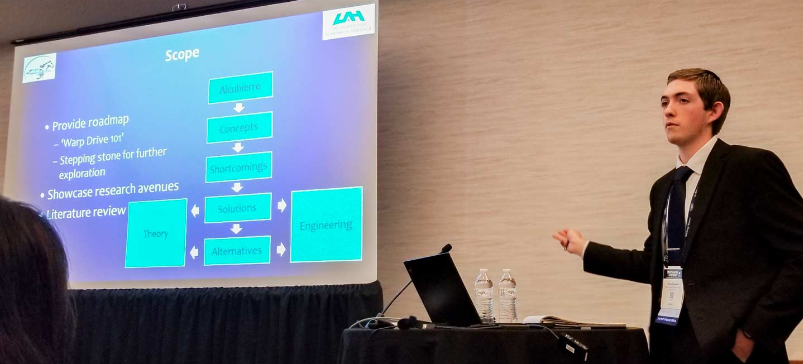The warp drive is now a little less impossible
How feasible are Warp Drives?
A new theory opens the door to the possibility of creating a real warp drive (in the future!).
The trick is to make space-time travelling around the ship and not the other way around, but the energy requirements are, for now, enormous.
Joseph Agnew, senior mechanical engineer at the University of Alabama in Huntsville, was driven to pursue his scientific career by his passion for Star Trek: when he was still in his first year of high school, Agnew had already developed an interest in mathematics and engineering, all because he was struck by the warp drive".

And, recently, Agnew presented his study on a "warp drive" at the American Institute of Aeronautics and Astronautics Propulsion and Energy Forum in Indianapolis.
Travelling at the speed of light?
Obviously not! Phisically we are not able to travel at the speed of light, but even if we were, the crew on board would not survive, crushed by the acceleration.
Hence Agnew's theory: move space-time around the ship, curving space-time so that a space ship wrapped in a bubble can pass through it.
One particular concept, which will be discussed here, stood out among
the rest, and was brought into existence mathematically through the
work of Miguel Alcubierre. Inspired in part by the drive of like name in
the Star Trek series, he devised this metric which served as a solution
for Einstein’s General Relativity Equations, and described a
fascinating superluminal-apparent concept.In essence, what this metric describes is a way of inducing a
curvature of spacetime in a manner akin to an ocean wave. One creates a
‘high-pressure’ curvature behind, and a ‘low pressure’ curvature in
front, and the vessel inside of this resulting ‘bubble’ is moved with
space to a destination.An Examination of Warp Theory and Technology to Determine the State of the Art and Feasibility
A huge energy requirement
Until some time ago it was thought that creating a warp drive required all the energy of the universe, in more recent times the theory has shrunk, indicating the energy of the mass of Jupiter.
This reduction required five to eight years of theoretical experiments to be achieved, so Agnew believes that it is not impossible to further reduce it.
The “warp drive” is still not taken very seriously by reseachers
According with Agnew speechs, one of the greatest is the fact that the concept of the “warp drive” is still not taken seriously in scientific circles:
In my experience, the mention of warp drive tends to bring chuckles to the conversation because it is so theoretical and right out of science fiction. In fact, often it is met with dismissive remarks, and used as an example of something totally outlandish, which is understandable. I know in my own case, I initially had grouped it, mentally, into the same category as typical superluminal concepts, since obviously they all violate the ‘speed of light is the ultimate speed’ assumption. It wasn’t until I dug into the theory more carefully that I realized it did not have these problems. I think there would/will be much more interest when individuals delve into the progress that has been made.
Joseph Agnew
However, there have been a number of recent developments that have helped such us the discovery of naturally occurring gravitational waves (GWSs) by LIGO scientists in 2016, which both confirmed a prediction made by Einstein a century ago and proves that the basis for the warp drive exists in nature.
As Agnew indicated, this is perhaps one of the most significant developments:
In the past 5-10 years or so, there has been a lot of excellent progress along the lines of predicting the anticipated effects of the drive, determining how one might bring it into existence, reinforcing fundamental assumptions and concepts, and, my personal favorite, ways to test the theory in a laboratory.
The LIGO discovery a few years back was, in my opinion, a huge leap forward in science, since it proved, experimentally, that spacetime can ‘warp’ and bend in the presence of enormous gravitational fields, and this is propagated out across the universe in a way that we can measure. Before, there was an understanding that this was likely the case, thanks to Einstein, but we know for certain now.Joseph Agnew
If the warp engine is possible, even with technologies and energy resources that we don't yet have, an interesting aspect to think about is this: someone else, in the future, might be able to do it!
(for more technical details, plese refers to the links below)